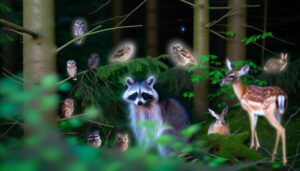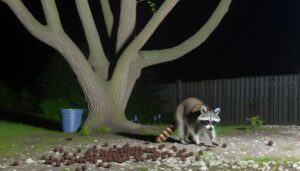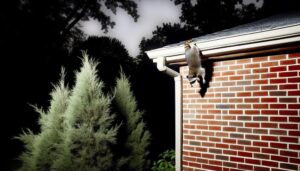How Do Raccoons Live in Sewers?
Raccoons demonstrate remarkable adaptability, allowing them to thrive in both urban and natural environments. In cities, their opportunistic behavior leads them to occupy unconventional habitats, including sewers.
This subterranean setting provides protection from predators and harsh weather, while offering access to food and water. Motion-activated cameras and tracking devices confirm raccoons' presence and nocturnal activities within urban sewer systems.
However, they face risks from exposure to harmful pathogens, toxic substances, and physical injuries. Despite the challenges, raccoons' survival strategies show resilience and adaptation, making their study essential for understanding urban wildlife dynamics and potential health risks.
Learn more about their fascinating urban lives.
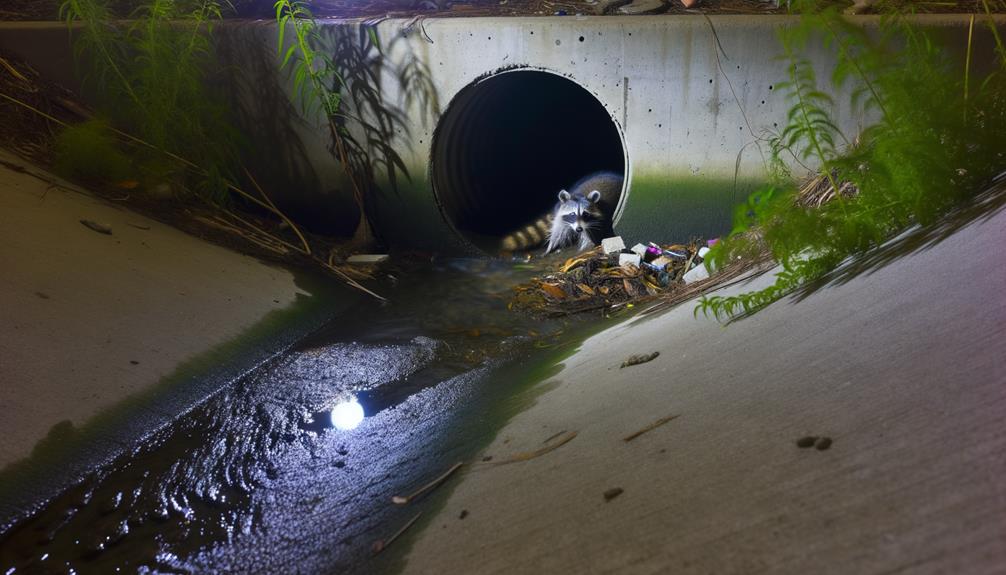
Key Takeaways
- Raccoons adapt to urban sewer systems due to protection from predators and harsh weather.
- Urban sewers provide a consistent food supply from human waste, supporting raccoon survival.
- Sewers offer shelter but expose raccoons to harmful pathogens and toxic substances.
- Documented evidence shows raccoons navigate and nest in urban sewer systems.
- Raccoons' nocturnal behavior and problem-solving skills aid in their survival in sewers.
Raccoon Behavior and Adaptability
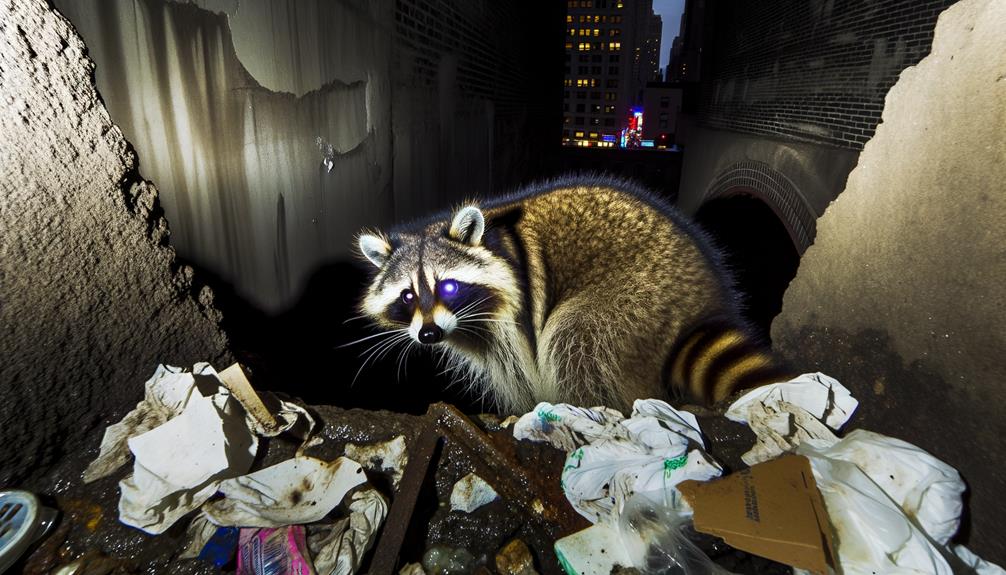
Raccoons, known for their remarkable adaptability, exhibit a wide range of behaviors that enable them to thrive in diverse environments. These nocturnal mammals possess acute problem-solving skills and dexterous forepaws, allowing them to manipulate objects and access food sources effectively.
Their omnivorous diet includes fruits, insects, small vertebrates, and human refuse, facilitating survival in various habitats. Raccoons are also proficient climbers and swimmers, utilizing trees and water bodies for foraging and refuge.
Their behavioral plasticity is evident in their ability to adjust activity patterns and foraging strategies based on environmental conditions. Additionally, raccoons exhibit complex social structures, often forming loose groups for mutual benefit.
Such behavioral versatility underscores their success in both natural and anthropogenic landscapes.
Urban Raccoons: A Common Sight
Given their remarkable adaptability and diverse behaviors, it is no surprise that raccoons have become a ubiquitous presence in urban environments. These nocturnal mammals have successfully integrated into cities by exploiting various food sources, from garbage bins to pet food left outdoors. Their dexterous front paws and advanced problem-solving skills enable them to access hard-to-reach areas, making urban landscapes an ideal habitat.
Observations indicate that raccoons exhibit little fear of human activity, often foraging in close proximity to residential areas. Additionally, their ability to climb and their opportunistic diet contribute to their thriving population in cities. The urban setting not only provides ample food but also numerous potential shelters, further facilitating their successful adaptation.
Typical Raccoon Habitats
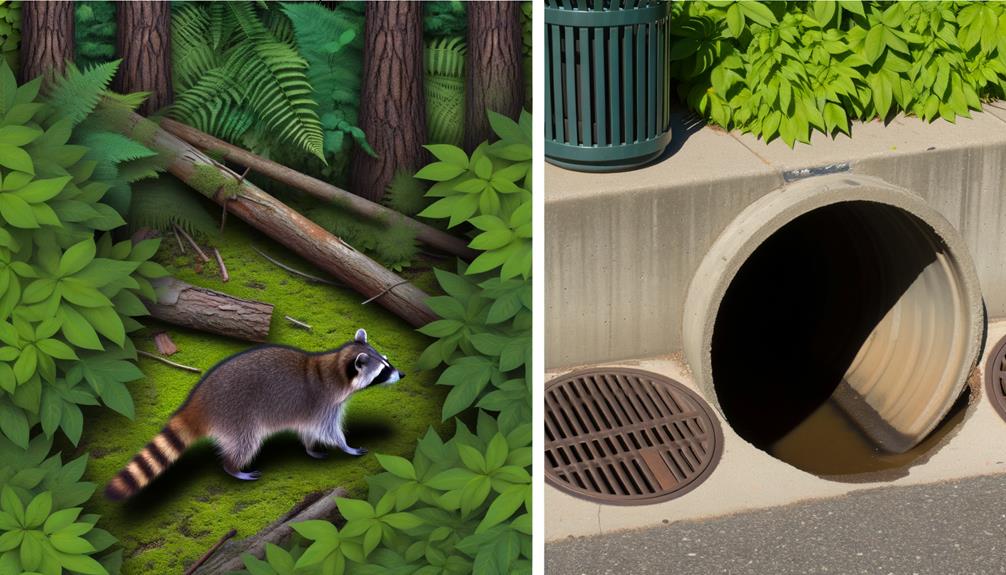
Raccoons exhibit a high degree of adaptability in their choice of habitats. They commonly occupy both urban living spaces and natural woodland areas. In urban environments, they are frequently found in attics, basements, and even sewers, leveraging human structures for shelter and food sources.
Conversely, in natural settings, raccoons prefer densely vegetated areas near water sources. These locations provide ample foraging opportunities and protection from predators.
Urban Living Spaces
In urban environments, raccoons often adapt to a variety of habitats including attics, basements, abandoned buildings, and storm drains. These adaptable mammals are known for their resourcefulness in exploiting human-modified landscapes.
Attics and basements provide warmth and shelter, while abandoned buildings offer seclusion. Storm drains and sewers are especially attractive as they provide a network of hidden pathways and consistent access to water.
Additionally, raccoons are highly opportunistic feeders, making urban areas with readily available food sources, such as trash bins and pet food, particularly appealing. Their nocturnal nature allows them to navigate these spaces with minimal human interaction, further facilitating their survival in densely populated environments.
Understanding these habitats highlights raccoons' remarkable adaptability and resilience.
Natural Woodland Areas
While raccoons have shown remarkable adaptability in urban settings, their natural habitats in woodland areas provide the essential ecological conditions necessary for their survival and reproduction. These woodland areas offer a rich diversity of food sources, including fruits, nuts, insects, and small vertebrates, which are pivotal for their omnivorous diet.
Dense foliage and ample tree cover furnish raccoons with necessary shelter and nesting sites, safeguarding them from predators. The presence of water bodies such as streams or ponds is crucial for hydration and foraging. Additionally, the complexity of the forest floor, with its abundance of fallen logs and underbrush, provides additional foraging opportunities and concealment.
These elements collectively support the raccoon's physiological and behavioral needs.
Sewers as Potential Habitats
Urban environments inadvertently provide raccoons with access to sewers, offering a unique subterranean habitat that meets their adaptive survival needs. Sewers present raccoons with several advantages, including protection from predators and harsh weather conditions.
The labyrinthine structure of sewer systems allows raccoons to establish territories and navigate efficiently, capitalizing on their innate climbing and problem-solving abilities. Moreover, the availability of food sources, such as discarded human waste and smaller urban wildlife, supports their nutritional requirements.
The constant flow of water within sewers also guarantees that raccoons have access to hydration. These factors collectively create a suitable environment for raccoons, enabling them to thrive even in the heart of urban landscapes.
Evidence of Sewer Dwelling
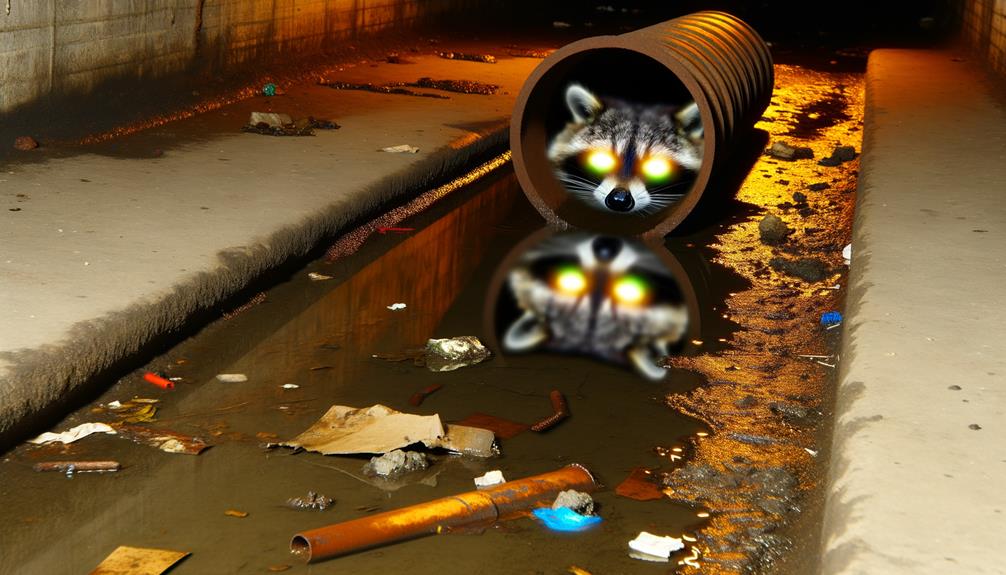
Numerous field studies and anecdotal reports have documented the presence of raccoons within urban sewer systems, providing substantial evidence of their habitation in these subterranean environments. Researchers have utilized various methods such as motion-activated cameras, tracking devices, and direct observations to confirm raccoon activity in these areas. These studies reveal patterns of nocturnal behavior, nesting sites, and food scavenging activities within the sewer networks.
| Observation Method | Key Findings |
|---|---|
| Motion-activated cameras | Captured images of raccoons entering/exiting |
| Tracking devices | Mapped movement patterns between sewers |
| Direct observations | Noted nesting sites and food sources |
| Anecdotal reports | Frequent sightings by maintenance workers |
| Population surveys | High raccoon density in urban areas |
These findings collectively support the hypothesis that raccoons have adapted to urban sewer environments.
Comparing Sewers to Natural Habitats
When comparing sewers to natural habitats such as forests, several significant differences arise that impact raccoon behavior and adaptation.
Urban environments present unique challenges, especially regarding food availability and shelter options, which differ markedly from those found in their traditional forest habitats.
Understanding these distinctions is vital for evaluating the feasibility and implications of raccoons inhabiting sewer systems.
Sewers Vs. Forests
The contrasting environments of sewers and forests offer distinct advantages and challenges for raccoons, influencing their behavior and adaptation strategies. Forests provide natural resources such as abundant food sources and shelter, while sewers offer consistent warmth and protection from larger predators. Each habitat imposes unique demands on raccoons' survival tactics, affecting their foraging, nesting, and social behaviors.
| Aspect | Sewers | Forests |
|---|---|---|
| Food Availability | Limited but consistent | Abundant but seasonal |
| Shelter | High protection | Natural dens |
| Predation Risk | Low | Moderate to high |
| Environmental Stability | Stable temperature | Variable climate |
Understanding these differences provides insights into raccoon adaptability and their capacity to thrive in diverse and changing environments.
Urban Adaptation Challenges
Raccoons exhibit remarkable adaptability when shifting from natural habitats to urban environments, facing distinct challenges and modifying their behaviors to traverse these contrasting settings effectively.
In natural habitats, raccoons rely on forested areas with abundant trees and water sources.
In urban areas, such as sewers, they encounter different physical structures and environmental conditions. The confined and often polluted environments of sewers contrast sharply with the open, cleaner natural habitats. Raccoons must adapt to navigating narrow, dark spaces and contend with potential exposure to harmful substances.
Additionally, the lack of natural predators in urban settings alters their behavior, making them bolder and more exploratory.
These adaptations highlight the species' resilience but also underscore the challenges posed by urbanization.
Food and Shelter
Adapting to urban environments, raccoons find sustenance and shelter within the confines of sewers, which starkly contrasts with their natural habitats where food sources and nesting options are more diverse and readily available.
Sewers offer raccoons a relatively consistent supply of food, often derived from human waste and discarded items. However, this diet lacks the nutritional variety found in their natural habitats, where raccoons consume a mix of fruits, nuts, insects, and small animals.
Shelter-wise, sewers provide protection from predators and harsh weather, yet lack the complex nesting opportunities available in wooded areas, such as tree cavities and dense foliage.
The artificial environment of sewers forces raccoons to adapt their behaviors and survival strategies substantially.
Risks of Sewer Living
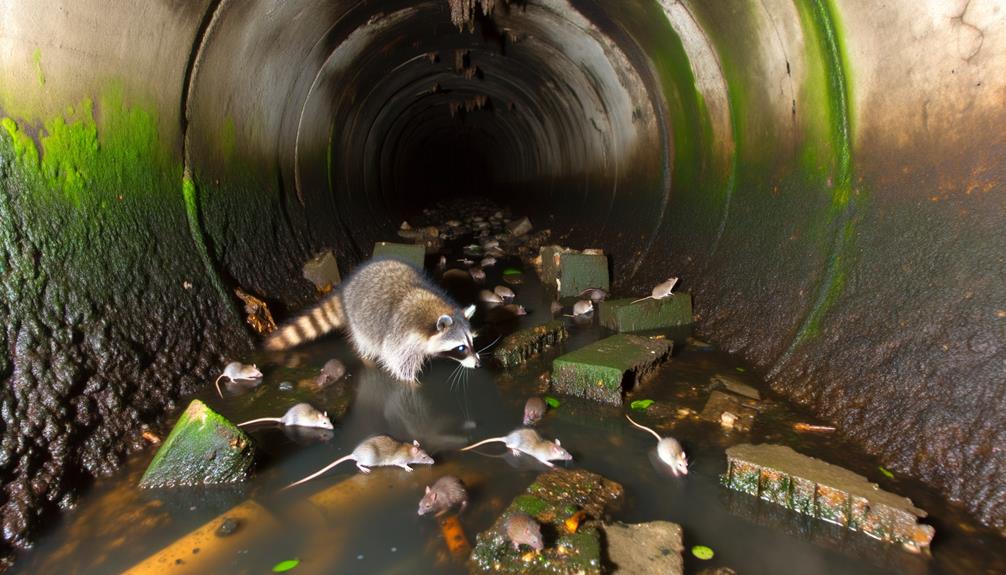
Exposure to harmful pathogens and toxic substances represents a significant health risk for raccoons inhabiting sewer systems. Sewers are rife with bacteria, viruses, and chemical pollutants that can cause severe infections and diseases.
Prolonged contact with contaminated water and waste materials can lead to gastrointestinal and respiratory issues in raccoons. Furthermore, the presence of industrial chemicals and heavy metals in sewer environments poses risks of poisoning and long-term organ damage.
The dark, confined spaces of sewers also increase the likelihood of physical injuries, such as cuts and abrasions, which can become infected. Additionally, the lack of natural light and fresh air may adversely affect raccoon behavior and overall well-being, further exacerbating the hazards associated with sewer living.
Raccoon Health Concerns
Raccoons residing in sewers are at heightened risk for disease transmission due to exposure to contaminated water and waste. These environments facilitate the proliferation of parasites and infections that can adversely affect raccoon health.
Notable concerns include leptospirosis, roundworm, and various bacterial infections, which can also pose zoonotic risks to humans and other wildlife.
Disease Transmission Risks
Due to their frequent contact with various pathogens in urban environments, raccoons pose significant risks for the transmission of diseases to humans and other animals. These nocturnal creatures are known carriers of several zoonotic diseases, which can be transmitted through direct contact or contaminated surfaces. Raccoons' ability to thrive in human-dominated landscapes exacerbates these risks.
- Rabies: A viral disease causing severe neurological symptoms, fatal if untreated.
- Leptospirosis: Bacterial infection leading to kidney damage, liver failure, or respiratory distress.
- Salmonellosis: Infection resulting in gastrointestinal distress, fever, and severe dehydration.
- Giardiasis: Parasitic infection causing chronic diarrhea and malabsorption.
- Baylisascaris procyonis: Raccoon roundworm leading to severe neurological damage in humans.
Understanding these risks is essential for public health and safety.
Parasites and Infections
How do parasites and infections impact the overall health of raccoons, given their pervasive presence in both urban and rural environments?
Raccoons are susceptible to a variety of parasites and infections, including Baylisascaris procyonis (raccoon roundworm), leptospirosis, and mange. These parasites can compromise their health to a great extent, affecting their ability to forage, reproduce, and evade predators.
For instance, Baylisascaris procyonis can cause severe neurological damage. Mange, caused by Sarcoptes scabiei mites, leads to debilitating skin conditions and secondary infections. Additionally, raccoons are vectors for diseases like rabies, posing risks to other wildlife and humans.
Understanding these health concerns is essential for wildlife management and public health strategies in both urban and rural settings.
Human-Raccoon Interactions
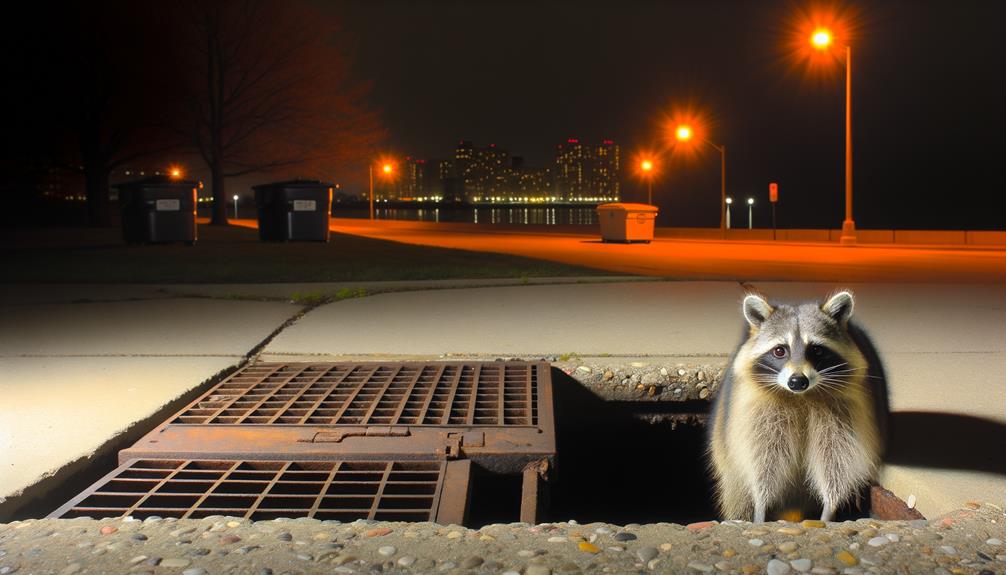
The interaction between humans and raccoons often involves complex dynamics, influenced by urban encroachment on raccoon habitats and the adaptability of these intelligent mammals. Raccoons have become adept at maneuvering urban landscapes, frequently foraging in trash bins and even accessing attics. These encounters can lead to both fascination and frustration among urban residents.
Despite their remarkable adaptability, raccoons can pose health risks through the transmission of diseases such as rabies and leptospirosis.
Unexpected sightings in urban backyards
Damage to property and gardens
Health concerns due to zoonotic diseases
Increased frequency of nocturnal noise disturbances
Emotional conflict between viewing raccoons as pests and wildlife
Understanding these interactions is essential for developing effective cohabitation strategies.
Preventing Raccoons in Sewers
While raccoons' adaptability allows them to thrive in urban environments, their presence in sewer systems requires specific preventive measures to mitigate potential hazards. Structural modifications such as installing grates or mesh coverings over sewer openings can effectively block entry points.
Regular inspections and maintenance are vital to identify and repair any breaches promptly. Additionally, waste management protocols should be enforced to minimize accessible food sources, thereby reducing the attraction for raccoons.
Public education campaigns can raise awareness about the importance of these measures and encourage community involvement. Implementing these strategies can help maintain the integrity of sewer infrastructure and protect public health, ensuring a balanced coexistence between urban wildlife and human activities.
Conclusion
To sum up, raccoons exhibit remarkable adaptability, frequently using urban settings, such as sewers, as habitats. Evidence indicates that although not their main preference, sewers provide raccoons with shelter and food access, similar to a stronghold offering sanctuary to intruders.
Nevertheless, these settings present considerable health hazards to raccoons and potential issues for human populations. Grasping raccoon behavior and habitat preferences is essential for creating successful strategies to deter raccoons from residing in sewers and reducing related risks.

